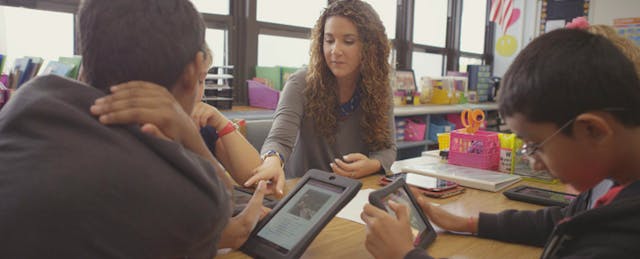IPads, Surfaces, Amplify tablets, Kindles--to the list of tablets vying a spot in the classroom add today's newcomer: an Android tablet, the Nexus 7, from Google. But what's likely to win over the hearts--and budgets--of schools won't have much to do with the hardware. Instead Google is betting that software--and services--will rule.
Today's debutante--Google's 7-inch Android-based tablet--will cost $229 apiece. There's also a $30 fee for management software. More devices are coming early next year, notably including the ASUS Transformer Pad (a 10-inch tablet) and the HP Slate Pro (an 8-inch tablet). (No word yet on the prices.)
But where Google hopes to turn heads is what happens when those devices turn on.
An IT director who turns on the first in a batch of Nexus tablets will have to spend a couple of minutes to set up the device and, say, load in a class list from a spreadsheet, says Rick Borovoy, product manager for Google Play for Education. But once that first device is ready, provisioning any additional device requires no more than "bumping" a new device with the administrator's. Borovoy said the goal was to enable someone to provision a class in under 10 minutes.
And that's just what happened, notes Joel Handler, IT Director from Hillsborough Public Schools in New Jersey, a school that has been piloting the Nexus tablets since last March. "We would never have tried to deploy 3,000 tablets in the middle of the year--but we did," he says. "We just kept bumping them along." (Hillsborough is a district of 7,400 students.)
Next difference: When teachers turn on their Nexus 7 tablets, they will be able to jump right into the freshly designed Google Play for Education store for the tablets. The store design caters to teachers. Software is neatly organized by areas (science, social studies, ELA and so on), by grade, by price and even by Common Core standards. Google is also paying educators who are part of the CUE network to review some apps. It signals those reviews with a yellow badge. So far, there are "thousands" of "edu-approved" apps, Borovoy says. (Like other online stores, Google offers developers a 30/70 revenue split.)
Best twist: When teachers find an app that they want to use, a check-out screen gives them the option of using a school-designated purchase order, rather than, say, charging their own credit card and later trying to get reimbursed. "Having the purchase order is key," says Hillsborough's Handler.
Handler says that Hillsborough's transformation to digital curriculum began about three years ago when the school started rolling out Chromebooks for students in grades 5 through 12. About 900 Chromebooks went home with students in the evenings last year; 22% wound up broken. "One big thing is how do we insure these devices," Handler notes. Yet even though the school has not yet hit a 1:1 Chromebook:student ratio for these older students, it has vaulted ahead in using tablets with younger students. Every K-4 student in the Hillsborough district now uses a Google tablet, Handler says.
At the end of the day, however, Handler emphasizes the technology is starting to melt into the woodwork. Instead the school is focusing on its three goals for using technology with students, namely helping them:
- Create, collate and publish digital content;
- Engage in asynchronous learning;
- Explore the world outside the classroom.
"It's all about putting learning into the hands of students," Handler adds.

Edtech developers who want to explore how they can get an app in the Google Play for Education store should check out these details or watch this video.


